Development of high-tech agriculture in the context of industrialization and urbanization: The case of Vietnam
The aim of this article is to assess the importance and development
of high-tech agriculture in Vietnam under the context of
industrialization and urbanization. Due to pressure from international
economic integration and climate change in recent years, high-tech
agriculture seems to be an affordable direction for Vietnam to
renovate the agricultural sector. Although high-tech agriculture has
existed in different locals and sub-sectors of agriculture such as crop,
livestock, and aquaculture, and Vietnam has obtained initial
achievements in adopting high-tech agriculture, this country has to
face a number of challenges related to land, credit, information
technology, and human resources in the process of developing hightech agriculture. Lastly, policies are recommended to facilitate the
development of high-tech agriculture in Vietnam.
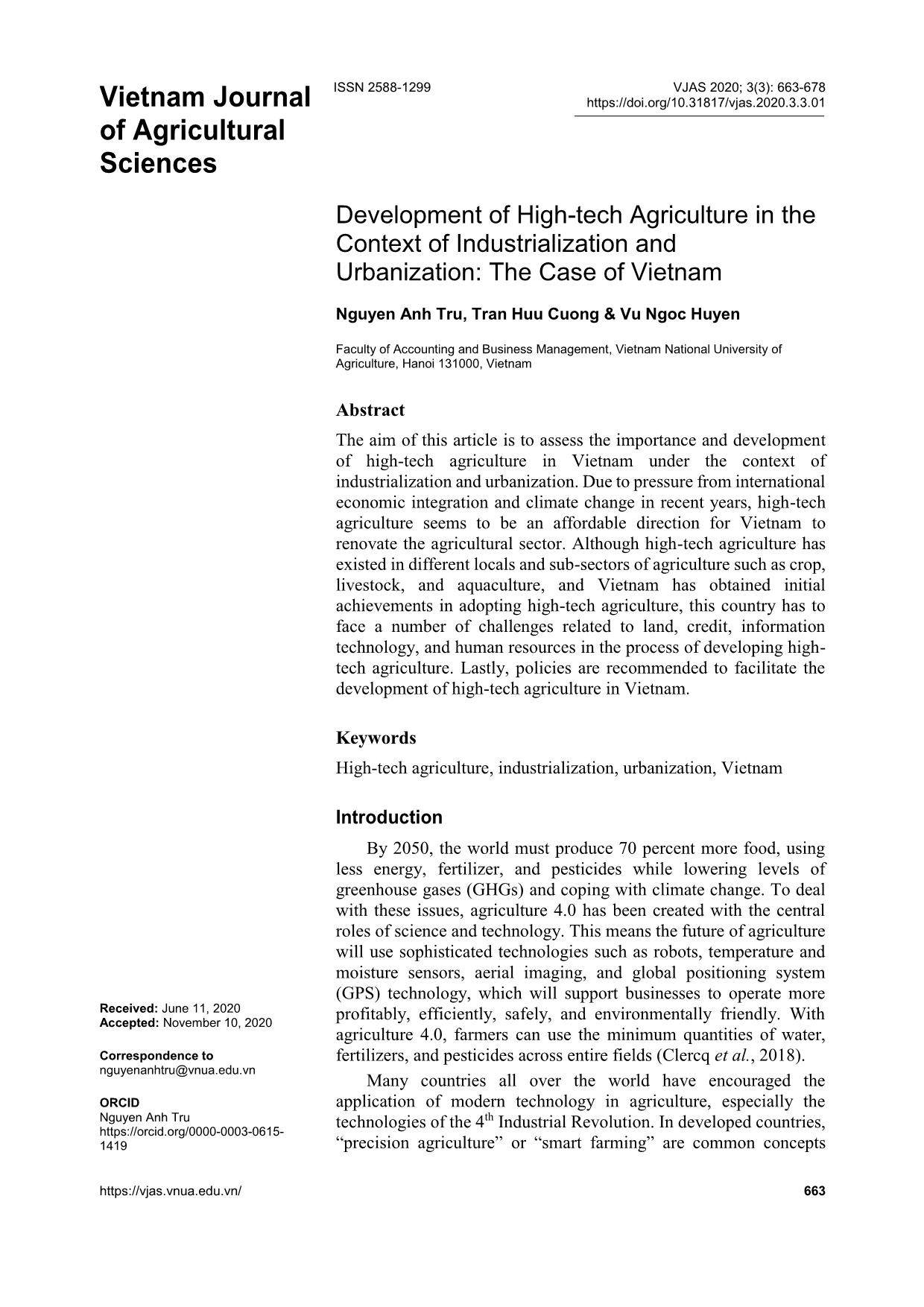
Trang 1
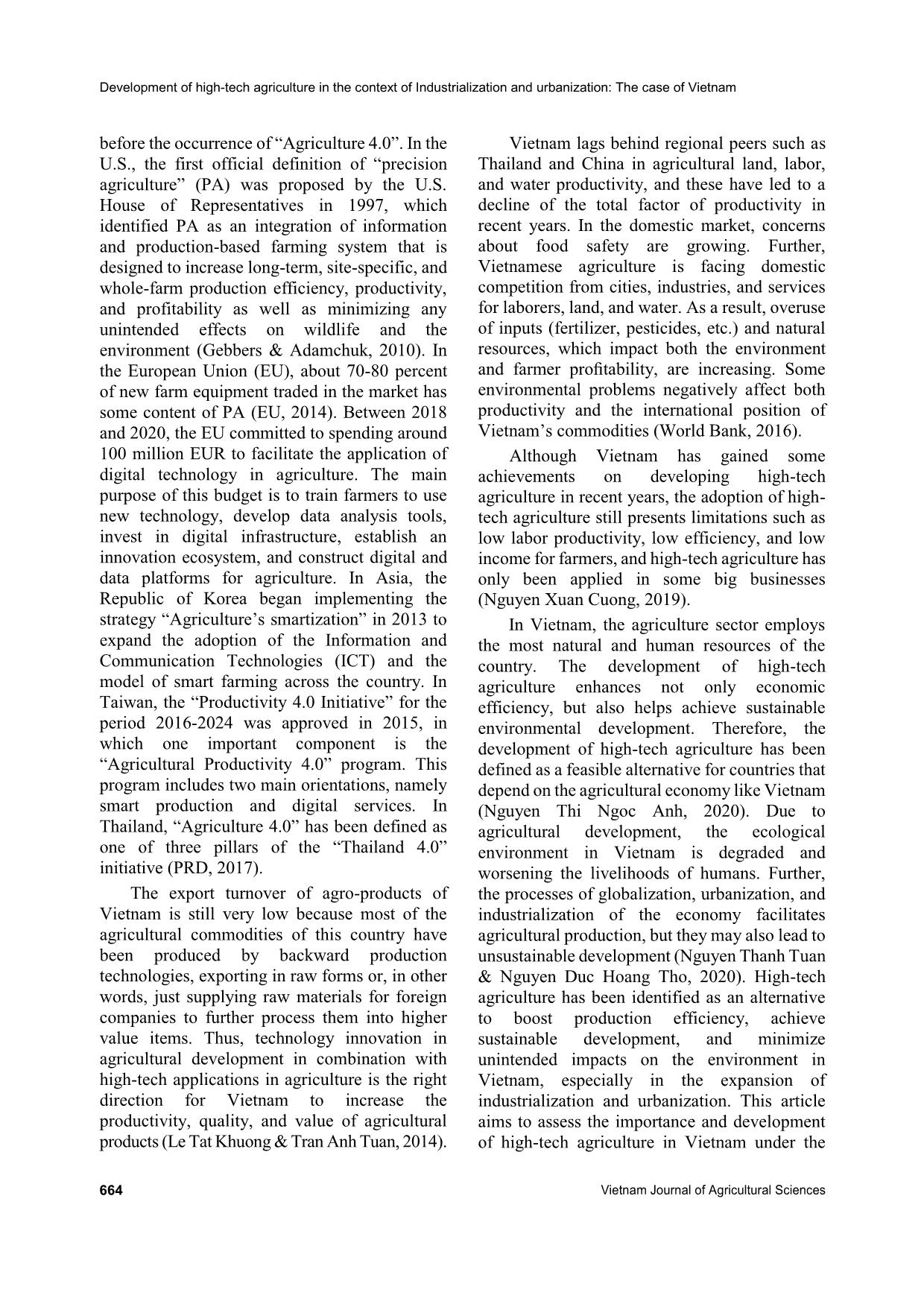
Trang 2

Trang 3
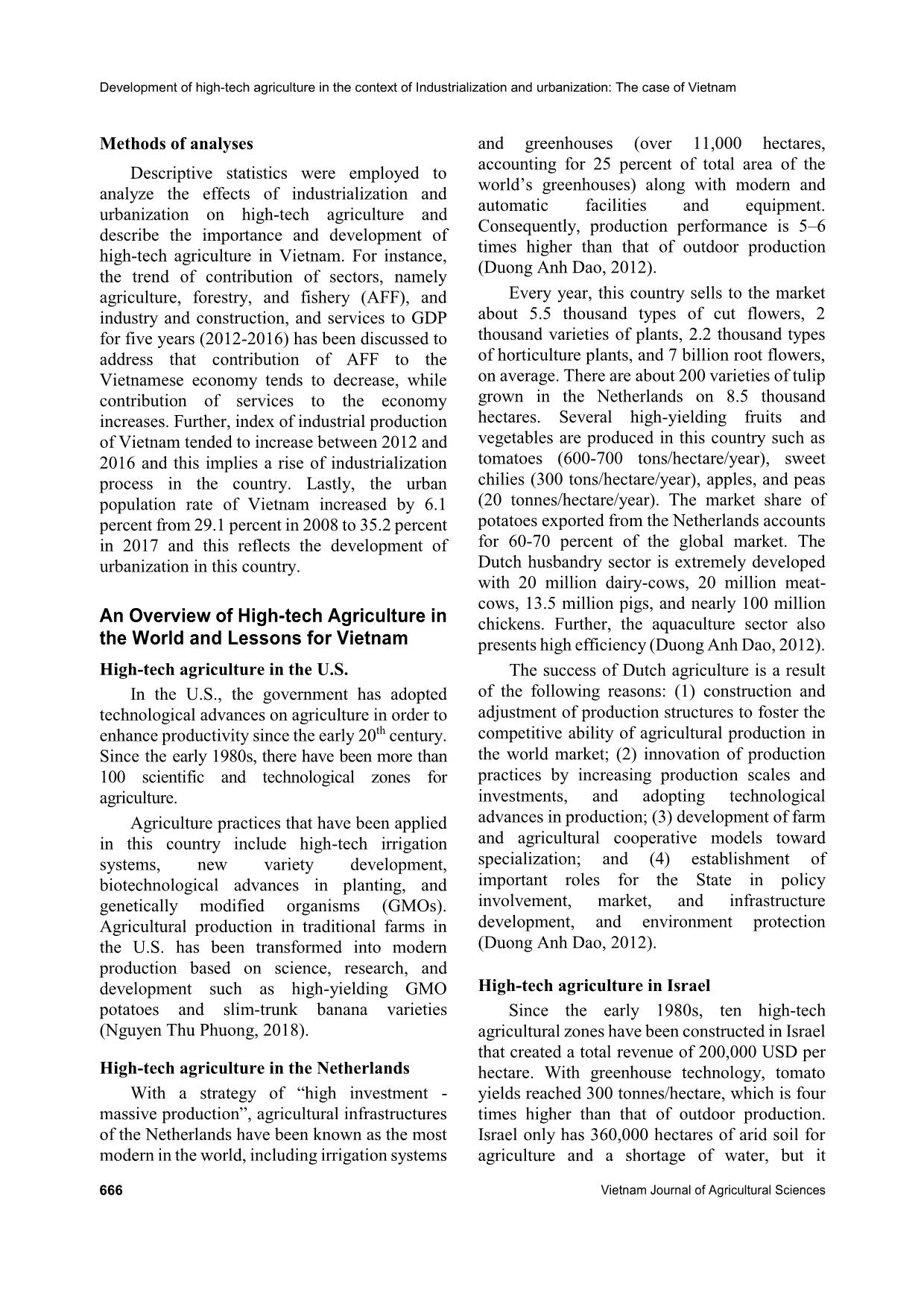
Trang 4
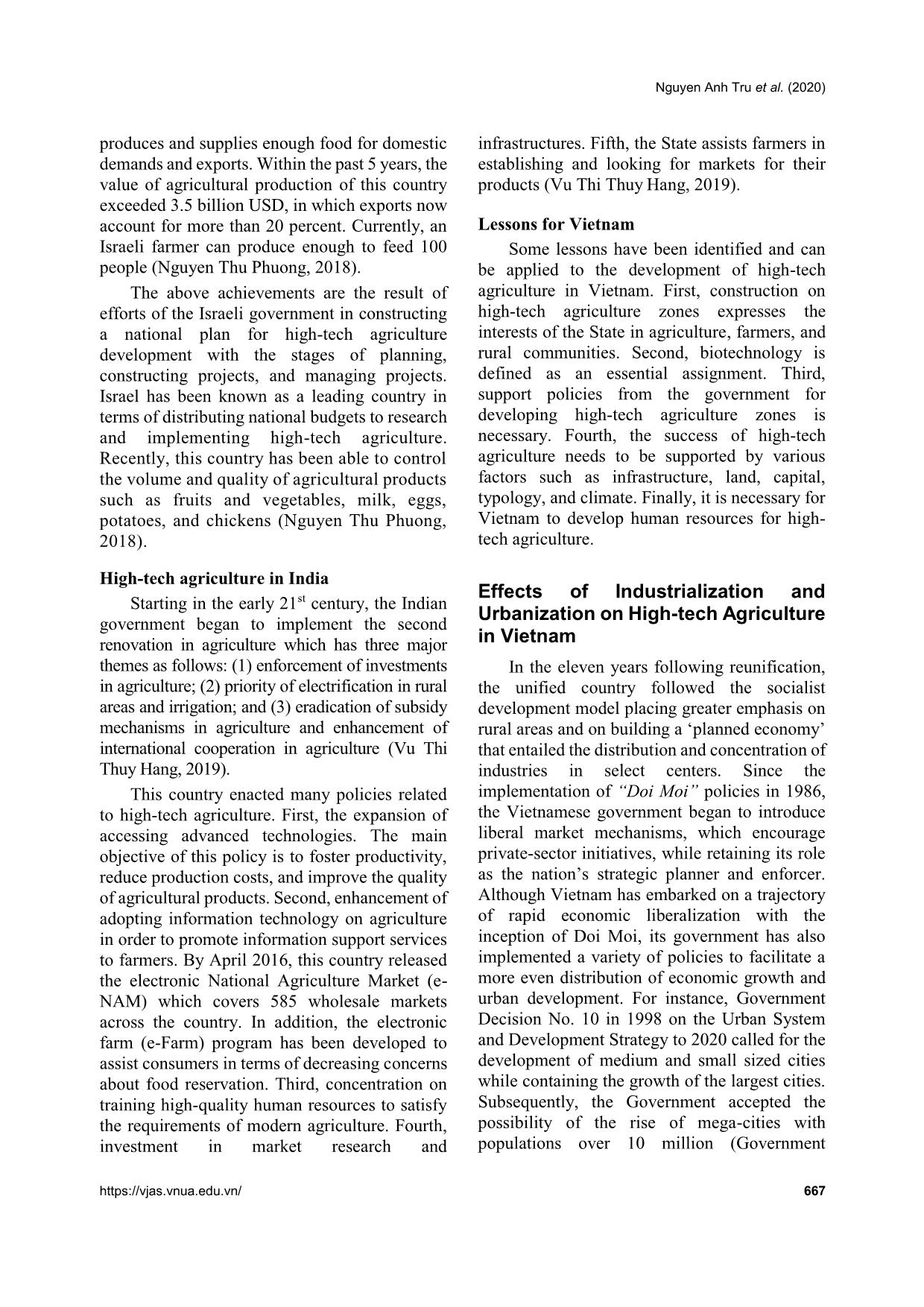
Trang 5
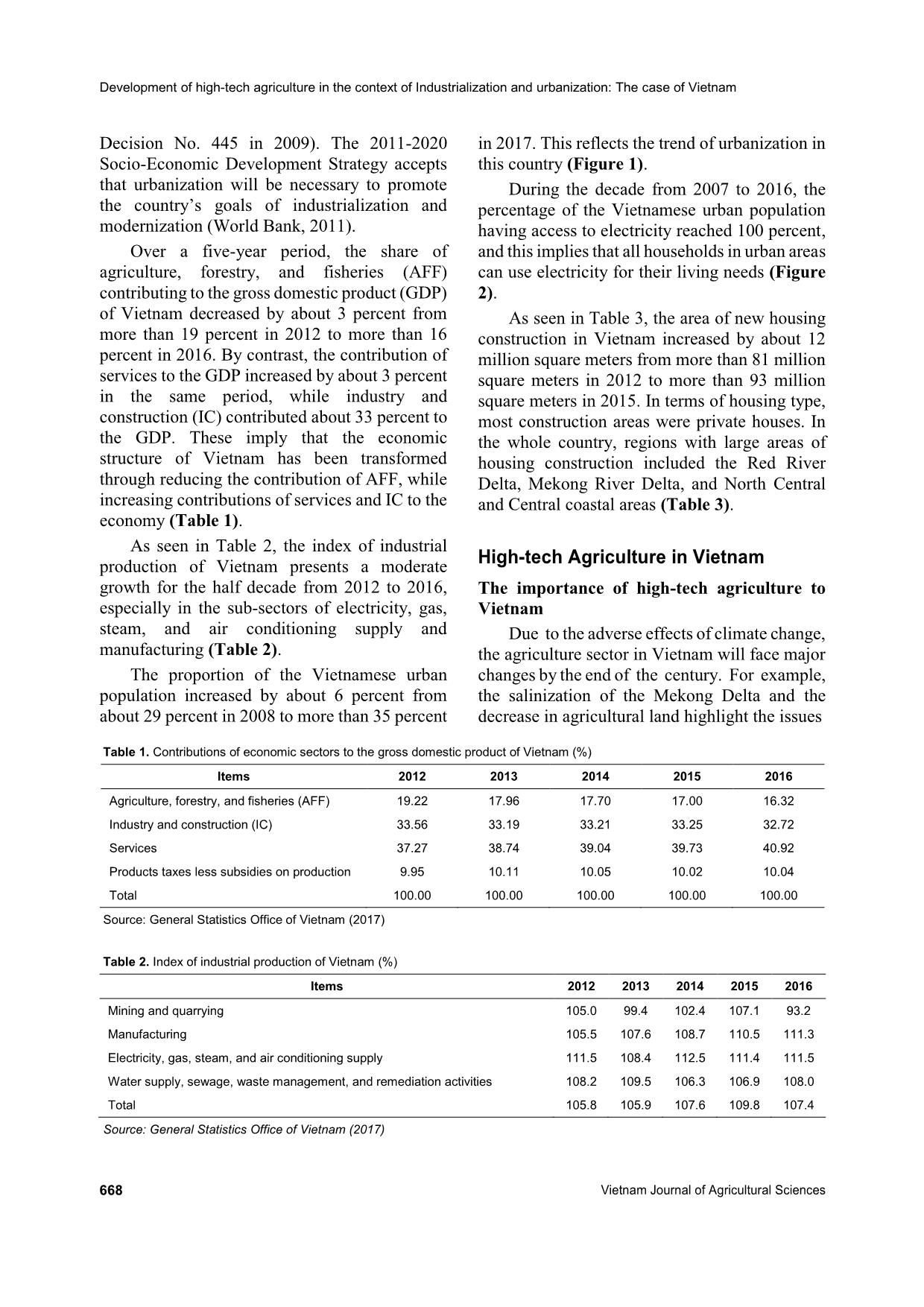
Trang 6
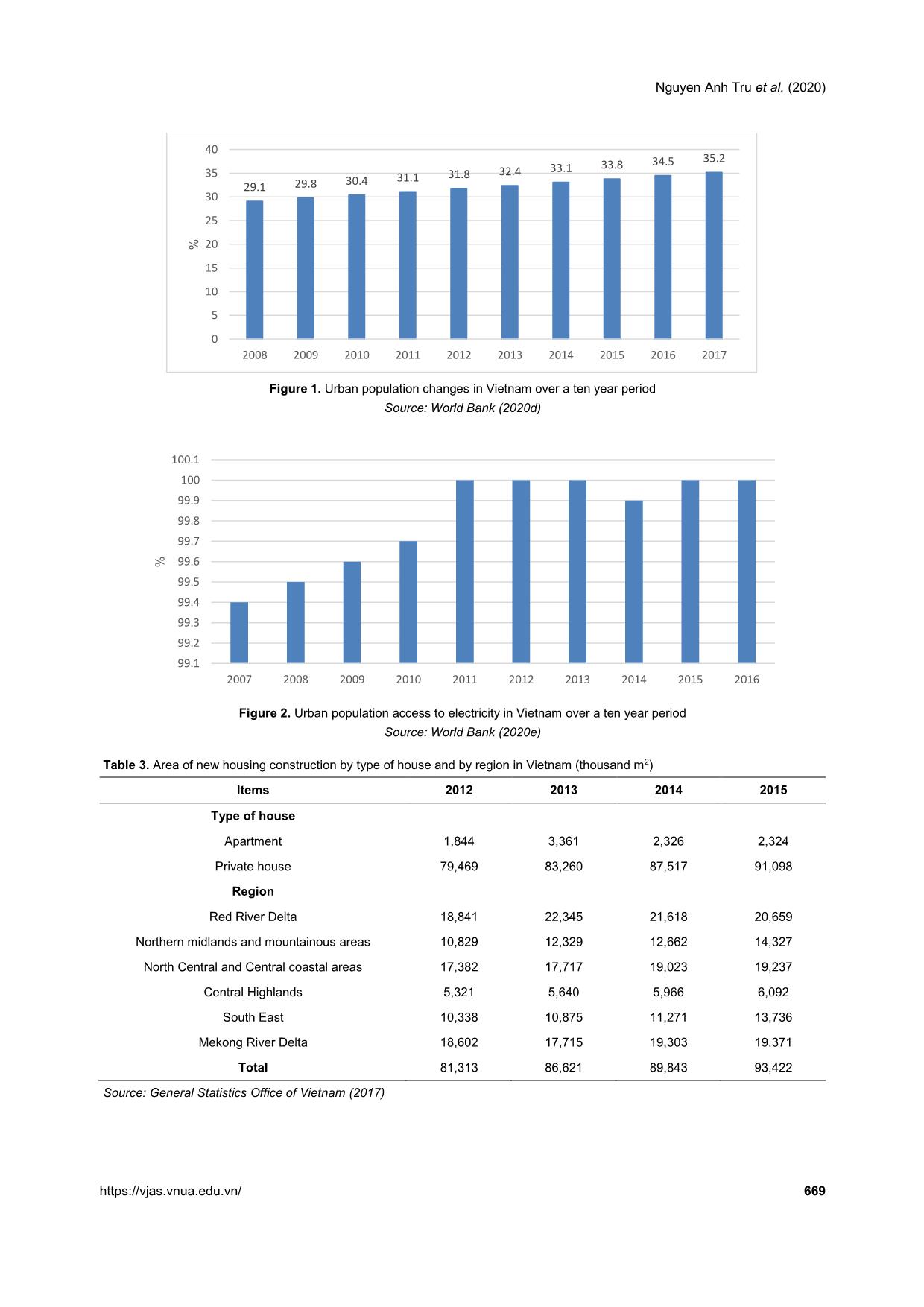
Trang 7
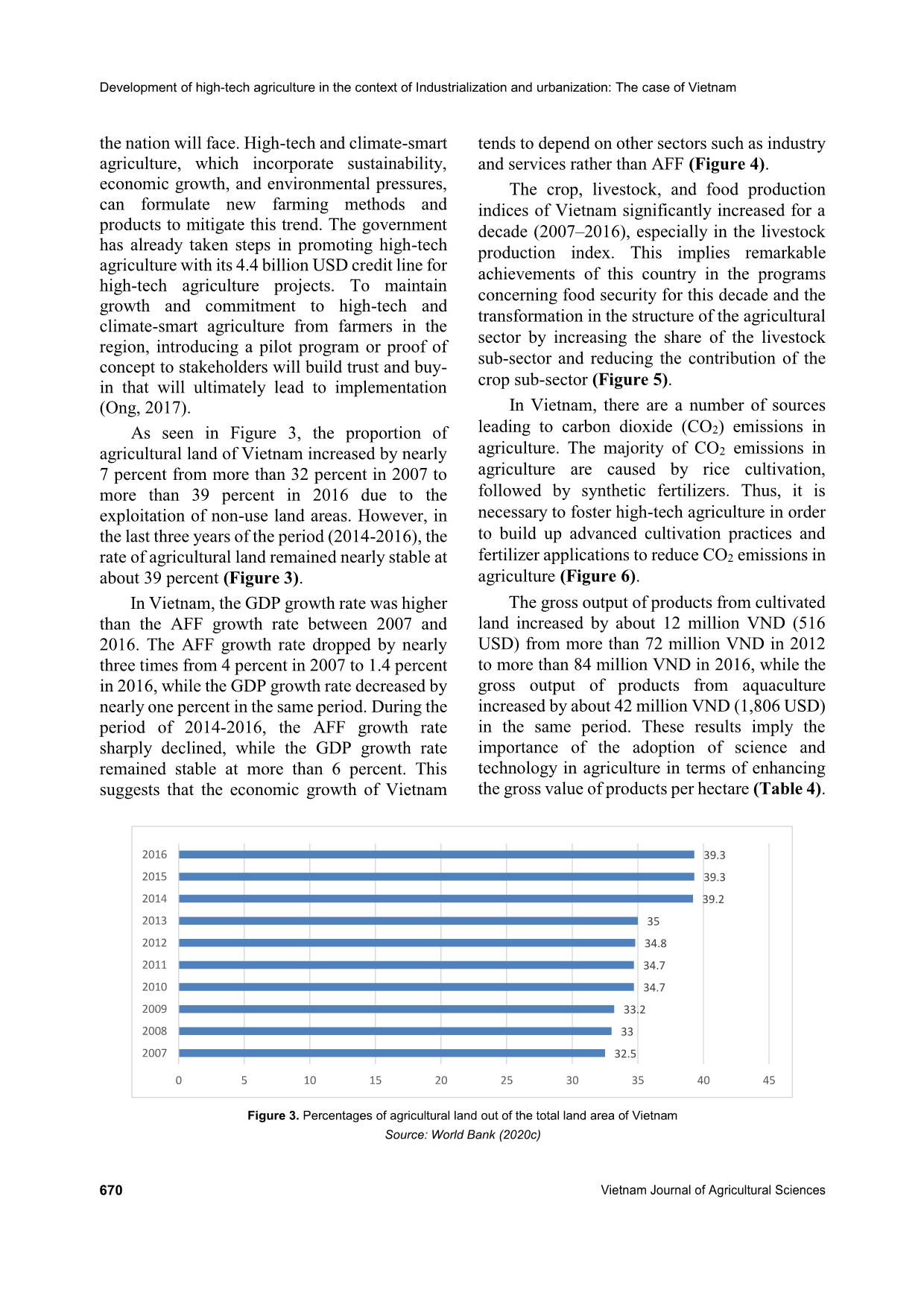
Trang 8
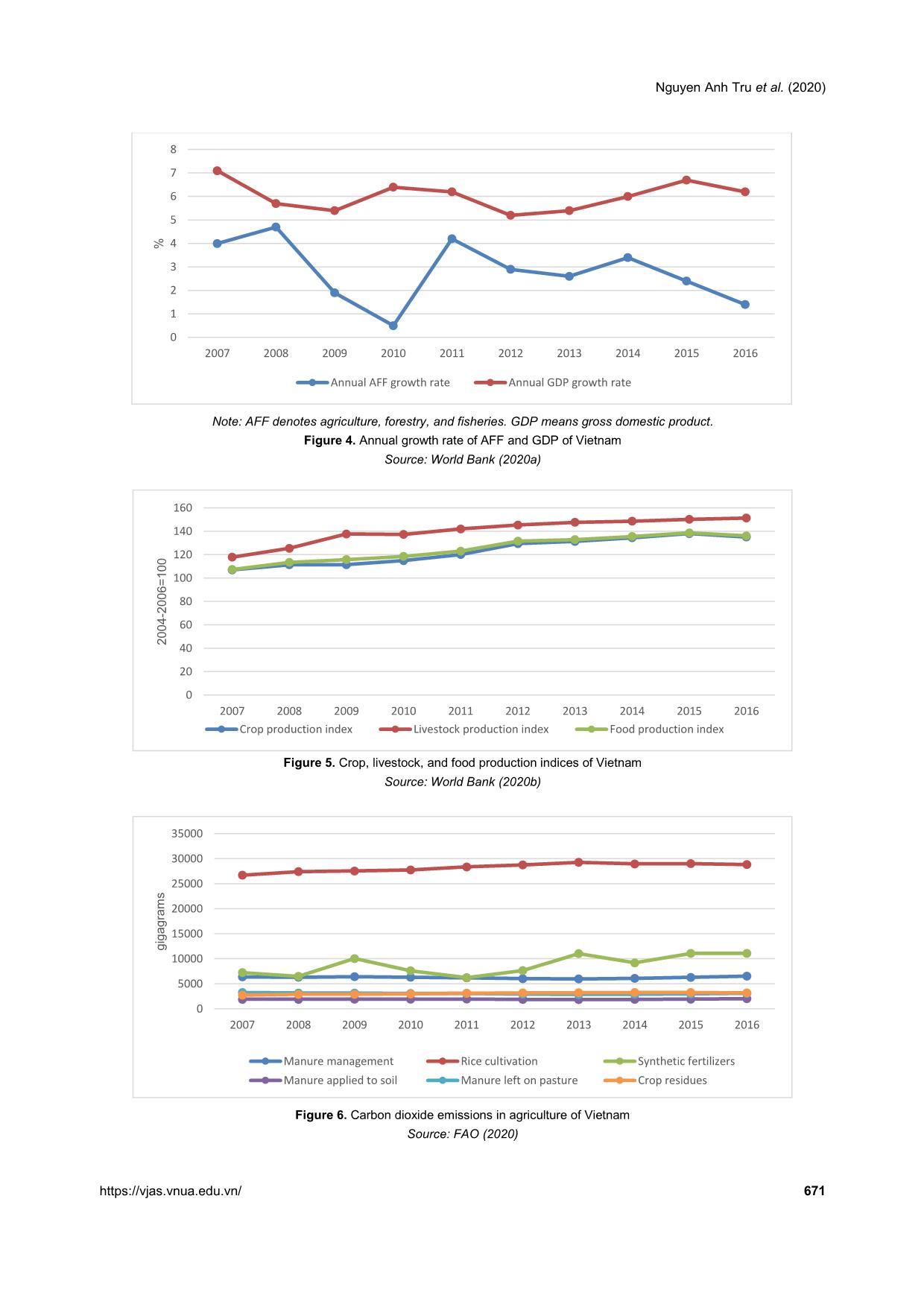
Trang 9
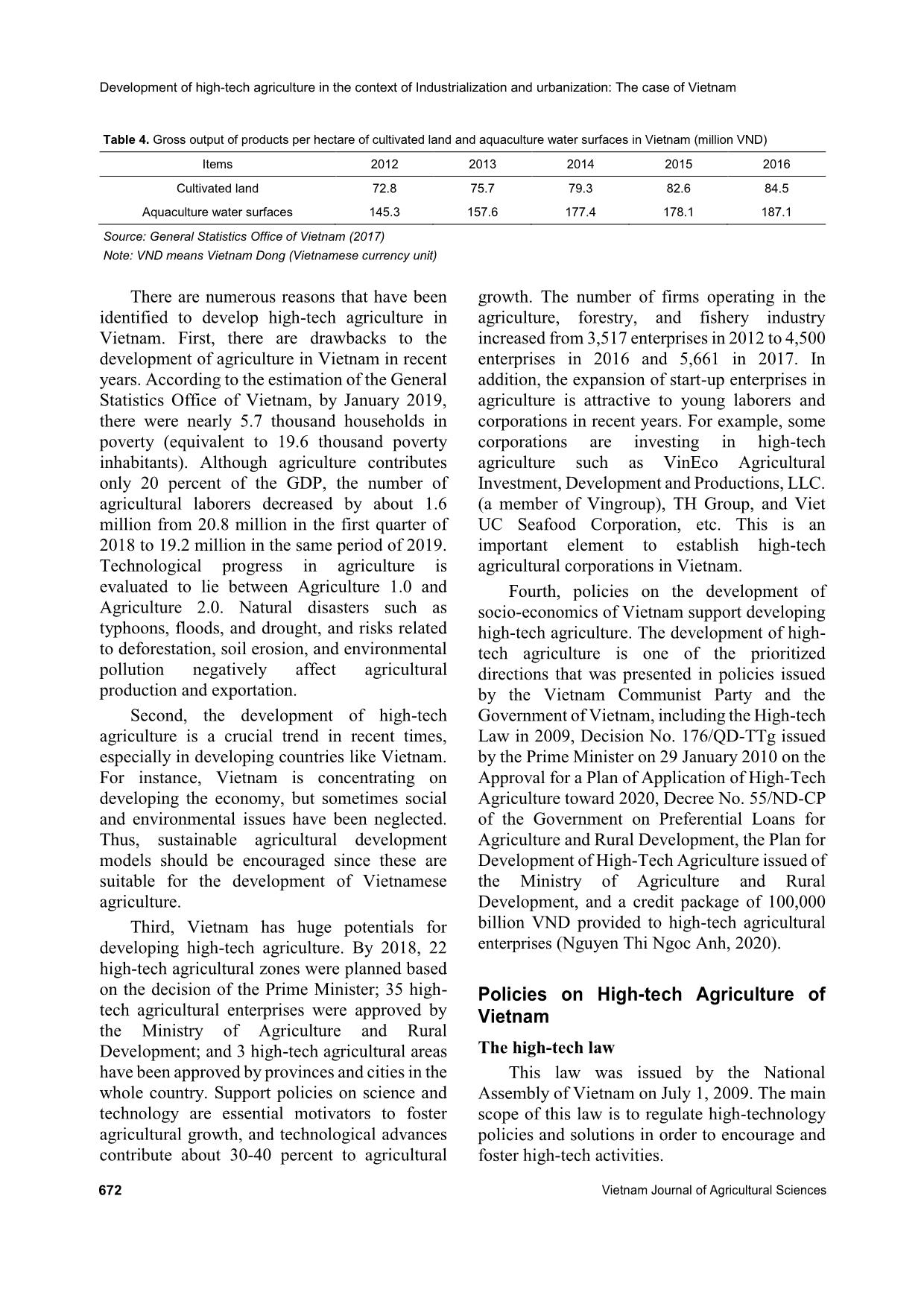
Trang 10
Tải về để xem bản đầy đủ
Tóm tắt nội dung tài liệu: Development of high-tech agriculture in the context of industrialization and urbanization: The case of Vietnam
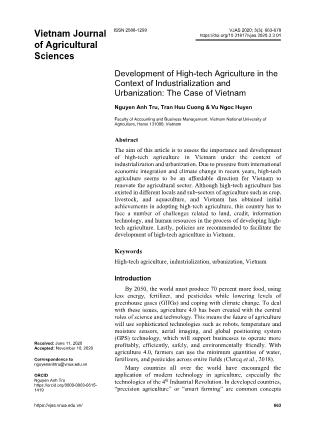
support policy for high-tech agriculture is ineffective because the application of high-tech requires a huge amount of investment, while capital recovery is slow. The shortage of high- quality human resources to manage and operate modern equipment is another problem for Vietnam to implement high-tech agriculture. With large-scale agricultural production, farmers should be agricultural workers and shareholders of agricultural enterprises (Luu Tien Dung & Nguyen Thi Kim Hiep, 2017). Nguyen Anh Tru et al. (2020) https://vjas.vnua.edu.vn/ 675 The application of ICT in Vietnamese agriculture is still in its early stages. Some enterprises have started to provide services that support decision-making by providing information on weather, production methodologies, or markets. Some have also established experimental farms, allowing them to measure the effectiveness of their production system using ICT equipment. Although there has not yet been sufficient analysis of these experiments, there is a growing expectation that ICT application will make agriculture more efficient and create more added value. Given urban consumers’ increasing interest in “safe” or “green” products and the growing presence of foreign retailers, demand for precision agriculture will surely increase in the future. Increased opportunities to export agricultural products thanks to Vietnam’s participation in free trade agreements will also increase demand for ICT applications since those products must be produced in accordance with importers’ certification requirements. The increased connectivity brought by ICT may also benefit the many who have recently shifted to these new commodities, including corporate farms and the farmers who switched from grain to non-grain crops, who will need information on production methodology and markets. Moreover, ICT application is also expected to enable more efficient production, reduce water use and other inputs, and reduce the labor requirements (Sakata, 2019). Opportunities and Challenges for High- tech Agriculture in Vietnam Opportunities In order to respond to climate change and ensure food security and agricultural sustainability, the Government of Vietnam has adopted the “National Target Program to Respond to Climate Change and Rising Sea Levels” and the “Green Growth Strategy in the period 2011-2020, with a vision toward 2050” as well as developing organic farming methods and safe agriculture in Vietnam through collaborations with international organizations. Sustainable agricultural development usually concentrates on technologies such as preventing soil erosion, protecting soil and soil moisture, calculating farming possibilities, and terrace field methods for sloping terrains to increase vegetation covers; adopting active irrigation by building reservoirs and applying more effective methods like spraying and dripping; and designing complete processes for fertilization, nutrition, and wastewater treatment. Due to the development care of agricultural authorities as well as strengthening international investments for environment and climate change adaptations, high-tech agriculture development of Vietnam has made progress in recent years. Vietnamese enterprises have opportunities to access soft loans or non-refundable aids for agricultural practices towards environmental protection and adaptations to climate change from the UK Aid, the Australian Aid, the World Bank, and the ADB through the Vietnam Business Challenge Fund (VBCF), Vietnam Inclusive Innovation Project (VIIP), and other projects financed by the World Bank and coordinated by the Ministry of Planning and Investment (Nguyen Huu Ninh & Hoang Thi Bich Hop, 2019). Challenges Although there are many opportunities for developing high-tech agriculture in Vietnam, the country is also facing various challenges. High- tech agriculture development not only requires a full legal basis but also needs synchronous technological development, risk management, and risk forecast systems as well as enhancing international cooperation and facilitating massive participation of the private sector in agricultural production through public-private partnership (PPP) to expand economic opportunities for the private sector to ensure efficient agricultural production. Although the cooperation pattern between authorities, scientists, enterprises, and farmers has been expanded in agricultural production of Vietnam in recent decades, this pattern must overcome numerous existing bottlenecks. These challenges include an inconsistent environment for the engagement of the private sector in agricultural production and a shortage of Development of high-tech agriculture in the context of Industrialization and urbanization: The case of Vietnam 676 Vietnam Journal of Agricultural Sciences investment capital in agriculture due to high risk, slow capital recovery, and low profitability. Further, a lack of truth between parties in agricultural contracts is defined as another challenge. Both enterprises and farmers may easily break contracts signed in the cases that firms are unable to process and sell final products to the market or farmers sell their products to merchants to obtain higher prices. In addition, scientific and technical farming improvements in Vietnam lag behind advanced countries and the process of technology transfer from foreign counties to Vietnam is expensive. Finally, Vietnam is one of the largest rice- exporting countries in the world. Climate change affects not only Vietnam but also food security in the region and the world. According to an estimation of the United Nations in 2013, the global population will continue to rise, and the world’s population is predicted to reach 8.2 billion in 2025 and 9.6 billion in 2050. Worldwide agricultural production is more complex due to the adverse effects of climate change. Thus, Vietnam should promote regulations for a green and adaptive agricultural economy and support small and medium-sized enterprises to take part in global value chains that look toward sustainable development (Nguyen Huu Ninh & Hoang Thi Bich Hop, 2019). Conclusions and Policy Implications This article aims to examine the importance and development of high-tech agriculture in Vietnam under the context of industrialization and urbanization. Due to pressure from international economic integration and climate change in recent years, high-tech agriculture can be identified as a feasible direction for Vietnam to renovate the agricultural sector. Although high-tech agriculture has existed in different locals and sub-sectors of agriculture such as crop, livestock, and aquaculture, and Vietnam has gained initial achievements in adopting high-tech agriculture, this country has to face a number of challenges related to land, credit, IT, and human resources in the process of developing high-tech agriculture. There are several policies we recommended that should be implemented to facilitate the development of high-tech agriculture in Vietnam. First, high-tech agriculture must be considered as the top priority in agricultural reform. The government should clarify and solve land issues in order to encourage land accumulation for large-scale agricultural development. Specifically, quotas on agricultural land in the 2013 Land Law need to be removed or loosened to establish large-scale agricultural zones that are suitable for adopting high-tech agriculture. Second, implementation of consistent credit policies that assist businesses and farmers to develop and apply high-tech agriculture. For instance, a credit package worth 100 trillion VND (4.4 billion USD) to invest in the development of high-tech agriculture at lower than market rates provided by the government is necessary to encourage, support, and promote the development of high-tech farming applications. Third, the country should continue to improve policies on the promotion of research, innovation, incubation, transfer, technology development, and technology application to agricultural production, with an emphasis on policies to promote the scientific and technological potential of the contingent of scientists to assist enterprises in developing high- tech agriculture. Fourth, the country should encourage both domestic and foreign enterprises to invest in high-tech agriculture. To tackle this assignment, the government should introduce more specific policies in both medium and long terms. The public-private partnership model should be promoted to attract more investments in agriculture. Fifth, partnerships among the State, scientists, businesses, and farmers should be consolidated to ensure success of adopting high-tech agriculture. For example, the State should focus on constructing and releasing macro policies related to land, credit, taxes, science and technology, and human resource management. Scientists have responsibilities in researching and inventing new varieties, technology, and practices that can be adopted in high-tech agriculture. Enterprises and farmers are in charge of investing and implementing high-tech agriculture models. Finally, high-tech agriculture Nguyen Anh Tru et al. (2020) https://vjas.vnua.edu.vn/ 677 should be integrated into the programs on new rural and agricultural extensions to efficiently exploit resources and improve outcomes. References Nguyen Thi Ngoc Anh (2020). The role of technology in high-tech agricultural development in the context of social, ecological and economic transformation in Vietnam. VNU Journal of Science: Policy and Management Studies. 36(1): 8-18. Clercq M. D., Vats A. & Biel A. (2018). Agriculture 4.0: The future of farming technology. World Government Summit in Collaboration with Oliver Wyman. February 2018. Nguyen Xuan Cuong (2019). Development of sustainable high-tech agriculture. Journal of Propaganda. Retrieved from nong-nghiep-cong-nghe-cao-ben-vung-122963 on April 20, 2020 (in Vietnamese). Duong Anh Dao (2012). Study on the development of high- tech agriculture in Can Tho city. Master Thesis in Geography. Ho Chi Minh City University of Education, 2012 (in Vietnamese). EU (2014). Precision agriculture: An opportunity for EU farmers – potential support with the CAP 2014-2020. Retrieved from e/join/2014/529049/IPOL-AGRI_NT on December 15, 2020. FAO (2020). Agriculture total. Carbon dioxide emissions in agriculture of Vietnam. Retrieved from on April 20, 2020. Gebbers R. & Adamchuk V. I. (2010). Precision agriculture and food security. Science. 327(5967): 828-831. General Statistics Office of Vietnam (2017). Statistical Yearbook of Viet Nam 2016. Statistical Publishing House, Hanoi (in Vietnamese). Vu Thi Thuy Hang (2019). Development of high-tech agriculture in India and experience lessons for Viet Nam. Number & Events. Retrieved from dung-cong-nghe-cao-o-an-do-va-bai-hoc-cho-viet- nam.htm on April 20, 2020 (in Vietnamese). Le Tat Khuong & Tran Anh Tuan (2014). Some reflections on hi-tech application for agriculture development in Vietnam - Experiences and lessons learnt from China. Journal Science and Technology Policies and Management. 3(1): 48-59 (in Vietnamese). Luu Tien Dung & Nguyen Thi Kim Hiep (2017). The revolution of agriculture 4.0 and sustainable agriculture development in Viet Nam. International conference proceedings: Emerging issues in economics and business in the context of international integration. National Economics University, Ha Noi, December 2017. 317-328. Nguyen Huu Ninh & Hoang Thi Bich Hop (2019). Climate smart agriculture for development in Vietnam: Opportunities and challenges. Retrieved from on May 20, 2019. Ong B. (2017). Development of high-tech agriculture in Vietnam. Retrieved from https://publicpolicy.wharton.upenn.edu/live/news/203 6-development-of-high-tech-agriculture-in-vietnam on April 20, 2020. Nguyen Thu Phuong (2018). Managerial and development experience in high-tech agriculture in some countries and preference values. Industry and Trade Magazine. Retrieved from viet/kinh-nghiem-quan-ly-phat-trien-nong-nghiep- cong-nghe-cao-o-mot-so-nuoc-va-gia-tri-tham-khao- 55028.htm on April 20, 2020 (in Vietnamese). PRD (The Government Public Relation of Thailand) (2017). Intelligent SMES and smart agriculture in response to Thailand 4.0 policy. Retrieved from https://thailand.prd.go.th/main.php?filename=index on December 15, 2020. Sakata S. (2019). The application of information and communication technologies (ICT) in agriculture: Present status, opportunities, and challenges in Vietnam. New Trends and Challenges for Agriculture in the Mekong Region: From Food Security to Development of Agri-Businesses, BRC Research Report, Bangkok Research Center, JETRO Bangkok/IDE-JETRO, 2019. Nguyen Thanh Tuan & Nguyen Duc Hoang Tho (2020). Developing high-tech market and sustainable agriculture in Israel: Policy implications for Vietnam. World Bank (2011). Vietnam urbanization review. Technical Assistance Report. World Bank, November 2011. World Bank (2016). Transforming Vietnamese agriculture: Gaining more from less. Vietnam Development Report 2016. World Bank (2020a). World development indicators. Annual growth of agriculture, forestry and fisheries and GDP of Viet Nam. Retrieved from https://databank.worldbank.org/data/reports.aspx?sour ce=2&series=EN.ATM.CO2E.KT&country=# on April 20, 2020. World Bank (2020b). World development indicators. Crop, livestock and food indices of Viet Nam. Retrieved from https://databank.worldbank.org/data/reports.aspx?sour ce=2&series=EN.ATM.CO2E.KT&country=# on April 20, 2020. World Bank (2020c). World development indicators. Rate of agricultural land of Viet Nam. Retrieved from https://databank.worldbank.org/data/reports.aspx?sour ce=2&series=EN.ATM.CO2E.KT&country=# on April 20, 2020. World Bank (2020d). World development indicators. Rate of urban population of Viet Nam. Retrieved from Development of high-tech agriculture in the context of Industrialization and urbanization: The case of Vietnam 678 Vietnam Journal of Agricultural Sciences https://databank.worldbank.org/data/reports.aspx?sour ce=2&series=NV.IND.TOTL.ZS&country=# on April 20, 2020. World Bank (2020e). World development indicators. Rate of urban population access to electricity in Vietnam. Retrieved from https://databank.worldbank.org/data/reports.aspx?source=2 &series=EG.ELC.ACCS.ZS&country=# on April 20, 2020.
File đính kèm:
 development_of_high_tech_agriculture_in_the_context_of_indus.pdf
development_of_high_tech_agriculture_in_the_context_of_indus.pdf

